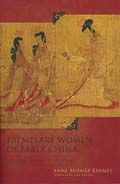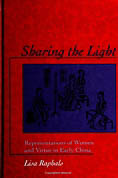start > Klassieke teksten > pre Qin t/m vroege Han > tekst
列女傳 Lienu Zhuan
Liènü Zhuàn
Engelse titel: Exemplary women of Early China
Compiled toward the end of the Former Han dynasty (202 B.C.- A.D. 9), Liu Xiang's (79-8 B.C.) Lienu zhuan or Traditions of Exemplary Women is the earliest extant book in the Chinese tradition solely devoted to the moral education of women. The book consists primarily of biographical accounts of women in early China who were noted for various virtues, though the final chapter concerns exemplars of feminine wickedness. After its composition the Lienu zhuan became the standard textbook for female education for the next two millennia, inspiring generations of Chinese women to cultivate not only traditional virtues such as filial piety and maternal kindness but lauding practices such as suicide and self-mutilation as a means to preserve chastity.
The seven categories of feminine behavior that Liu Xiang devised are (1) matronly deportment, (2) sagacious clarity, (3) benevolent wisdom, (4) chaste obedience, (5) pure righteousness, (6) rhetorical competence, and (7) depraved favoritism. Most of Liu's book is comprised of materials found in earlier texts,such as the Zuo zhuan and the Guoyu.
In my view, the new stress on Confucian learning in female education reflects, first of all, a utopian notion that was rapidly gaining currency in the later half of the Former Han dynasty, namely, that only when the entire population engages in self-cultivation will the empire achieve an era of great peace and high civilization. The Lienu zhuan, with its lessons that guide women from all levels of society, represents an effort to shape the entire female population in the Confucian mold. Moreover, given the ample opportunities for upward social mobility available to women during this period of time (no less than three slave women became empress at this time), the number of uneducated women at court was a cause for concern in an age when classical learning became the standard means of establishing a person's social and political credentials.
Second, from a purely practical perspective, the immense power that imperial women had acquired during this period prompted Confucians to use texts such as the Lienu zhuan to exert moral influence over women they could not control by political means. Contemporary memorials written to warn the emperor about the destructive influence of both uneducated and unscrupulous court women reach their most fevered pitch when an investigation of the untimely death of emperor Cheng (7 B.C.E.) revealed that the emperor's favorite but barren concubine had persuaded him to kill two infant sons born to other court women, leaving him without heirs and the dynasty in crisis. According to one source, it was for this emperor that Liu Xiang composed the Traditions of Exemplary Women in the hope that the emperor would use the text to instruct his womenfolk.
A final condition that prompted the compilation of this text was the new emphasis in the late Former Han on interpreting portents as Heaven's commentary on imperial rule. Since Confucian intellectuals viewed the emperor as the earthly guardian of the Heavenly or natural order, the emperor's departure from virtue was thought to generate cosmic imbalances in the two primordial powers, Yin and Yang. During the mid- and late Former Han, the Confucian concern with feminine virtue is once again demonstrated in records of portents, which were often read as signals of cosmic imbalance in which Yin (associated with feminine power) had overpowered Yang (the masculine power). Court ministers who interpreted such portents most often urged the emperor to correct the situation by making changes in the imperial harem, most notably, to diminish the power exerted by the emperor's mother and her kin. Because Confucians viewed filial piety as one of the cardinal virtues, those critical of empress dowagers had to employ indirect means, such as omenology, to attack such women. Similarly, schemes to educate women were, in part, one of the few options open to Confucians who, because they were unable to dislodge imperial women from positions of power, sought alternative means to exert control over their behavior. (Anne Behnke Kinney op site University of Virginia Library
Indeling tekst
Het boek bestaat uit 8 delen. De titels zijn van Anne Behnke Kinney.
1 母儀傳 The Maternal Models (14 biografieën)
2 賢明傳 The Worthy and Enlightened (15 biografieën)
3 仁智傳 The Sympathetic and Wise (15 biografieën)
4 貞順傳 The Chaste and Compliant (15 biografieën)
5 節義傳 The Principled and Righteous (15 biografieën)
6 辯通傳 The Accomplished Rhetoricians (15 biografieën)
7 孽嬖傳 The Depraved and Favorites (15 biografieën)
8 續列女傳 Supplemental Biographies(20 biografieën)
Online informatie:
Ulrich Theobald's Chinaknowledge: Lienü zhuanWikipedia: Biographies of Exemplary Women (engels)Chinese Text Project (Chinese tekst)XWomen, site bij het boek van Anne Behnke KinneyLiteratuur en vertalingen
Hieronder kunt u een selectie maken van de verschillende publicatievormen en de taal. Ik beperk me tot vier taalgebieden (Nederlands, Engels, Frans en Duits). De meeste literatuur is overigens engelstalig. U kunt bij teksttype ook apart de vertalingen selecteren en U kunt desgewenst ook een specifieke auteur zoeken.
Boeken 1 tot 6 van de 6

Guarde-Paz, César (2017). The Prescriptive Dialects Li and Yi in the Lienü zhuan. Philosophy East and West, Vol. 67 (3), pag. 651-666. *.

Hinsch, Bret (2004). The Textual History of Liu Xiang's Lienüzhuan. Monumenta Serica, Vol. Vol 52 Nr 1 p95-112 *.
Kinney, Anne (2014). Exemplary women of early China: The Lienu zhuan of Liu Xiang. Columbia University Press. *
ISBN13: 978-0231163095
Meer informatie...
Raphals, Lisa (1998). Sharing the Light: Representations of Women and Virtue in Early China. *
ISBN13: 978-0791438558
Ook online.
Meer informatie...

Wang, Robin R. (2010). Ideal Womanhood in Chinese Thought and Culture. Philosophy Compass, Vol. 5-8, pag. 635-644. *.
Meer informatie...

Boeken 1 tot 6 van de 6


